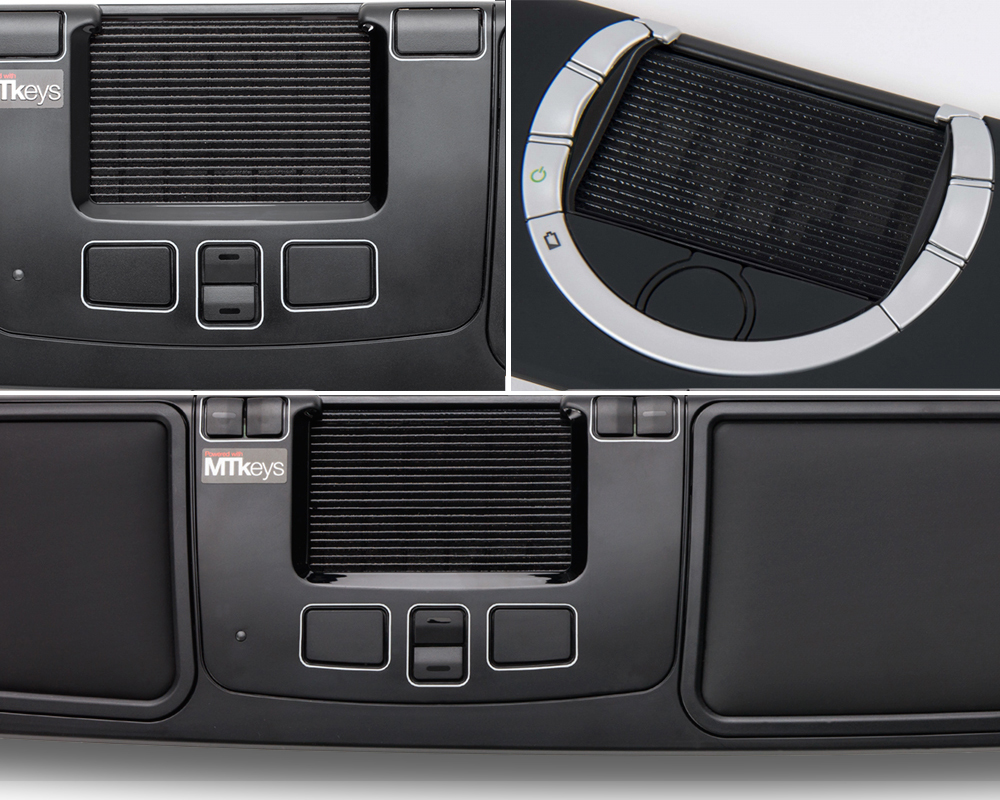
| Reduce Your Risk with |  |
Innovative Concepts — Intuitive Fingertip Control — Load-Balancing Designs | |
"ROLL" with the New DELTA
*click image for complete details on the DELTA | |
or "SLIDE" with the Originals | |
 |
 |
 |
 |
| Centralized Control Clusters |
 |
The Mousetrapper line of Mousing Solutions offer an innovative and strain-relieving means of moving away from traditional mousing. These "Central" or "Inline" mousing devices eliminate the awkward and high risk repetitive reach to the side for a traditional mouse by centrally positioning both the means of cursor control and the clicking controls just below the front edge of the keyboard. As a result, users require limited movement to reposition their fingers the short three and a half inches from the homerow position on the keyboard to being in full control of their mousing device. The injury-causing outward shoulder rotation is eliminated and users have the further advantage of being able to load-balance the mousing functions between both hands. In addition, the requirement to Grip and Pinch, as well as hover above the mouse buttons are the major sources which may lead to Repetitive Strain Injury (RSI) or Carpal Tunnel Syndrome.
Each model of the Mousetrapper has its own unique features but all models share the Centralized Control Cluster concept, Integrated Palm Supports, Full Programmability, Vertical Scrolling Controls and, above all, the unique and intuitive 2-D "Steering Pad" for cursor control.
| 2-D Steering Pad for Intuitive Cursor Control |
 |
While the Mousetrapper is easily customized and offers great benefits over traditional mousing positions its unique means of cursor control is probably the most valuable feature. Integrating the concepts of a treadmill and a touchpad, the "Steering Pad" provides users with a logical and intuitive 2-D Cursor Control that readily translates to on-screen cursor movement. The Steering Pad offers continuous "treadmill like" vertical movement while supporting simultaneous horizontal movement of the entire "track". This means that the movement generated by the fingertips translates into exactly the same x-y coordinate movement on the screen. Because the fingertips are by far the most sensitive and responsive part of the body it makes sense for them to provide the fine control necessary for computer work.
The Steering Pad, though similar in some ways to the more common touchpad, offers a superior level of tactile feedback that lends itself to a much higher and more accurate degree of control. The physical movement of the entire steering pad, the rotation of the treadmill, and the varying texture of the steering pad surface all serve to identify to the brain what movements are being generated and provide the data necessary for it to be continuously directing movement data to the fingertips. As a result, users "instinctively" and almost instantly adapt their movements to achieve the desired cursor movement. Another great advantage of the Steering Pad over a touchpad is that because the steering pad is not "touch sensitive" users are able to to rest multiple fingers on the surface without affecting the cursor movement. This also permits them to use multiple fingers for cursor control, letting the fingers work cooperatively to instinctively achieve the smoothest movement with the least degree of exertion or strain. On the other hand, most people who use a touchpad tend to rely on a single finger for all cursor control and need to do significantly more movement of the entire hand and even forearm.
One other key factor that makes a steering pad a better choice over a touchpad is that the generating a click requires only a small degree of pressure into a cushioned surface. Because the finger is already in contact with the surface there is no "impact" when clicking. This is noticeably different from a touchpad where the finger needs to first break contact and then be touched down again to activate a click against what is a rigid and unyielding surface. Users often find that the fingertips can become sensitive when using a touchpad but that would rarely be the case when using a Mousetrapper Steering Pad.
| Programmable Controls |
The centralized control clusters not only reduce the risk factors associated with the repetitive motions associated with traditional mouse positon and movement, they are also equipped to offer users the opportunity to further reduce the movements necessary to complete common tasks. The range of buttons available for customizing varies between 5 and 9, depending on the model of Mousetrapper. By employing the driver-free MTKeys software that is now accessible through a browser window (i.e no download required)—available for both Windows and Mac OS X—users are able select from a wide range of preconfigured common keyboard shortcuts or actions, mouse clicks (left, right, double), or can create their own custom keyboard combination shortcuts. The software will also retain multiple profiles which can be programmed to the Mousetrapper with a couple of clicks. This makes it a great solution for multi-user workstations or when switching between applications. AND, because the programming is retained on the Mousetrapper, it carries the programming wherever it is located

